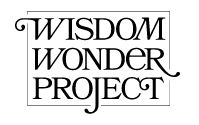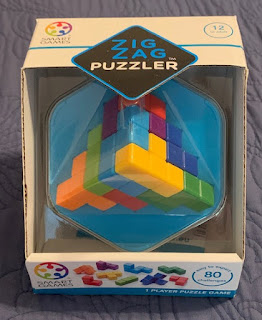I have a fun brain puzzle to share with you today from Timberdoodle, the Zig Zag Puzzler. I love the multi-colored, multi-geometric pieces. Right from the get-go, the Zig Zag Puzzler looks intriguing. This one player game is geared for students 12 and older.
Our Zig Zag Puzzler
What's included? This Smart Game includes a divot-like container that doubles as two playing boards, nine colorful pieces, and two manuals that contain 40 challenges each (40 2-D challenges in one and 40 3-D challenges in the other).
Above you can see the puzzle pieces. Their are 8 unique pieces and an extra red piece for a total of nine.
How do you play? A player begins by placing one or more of the nine, colorful pieces onto the playing board in specific positions. The manuals give you instructions for setting up the beginning of each challenge with a picture. The player then uses the remaining pieces to fill in their board. There are 5 levels of difficulty - Starting, Junior, Expert, Master and Wizard. As expected, the difficulty increases with each level. Every challenge has only one solution and the manuals contain a solution key in the back of the book with answers to every challenge. A has been working through the challenges and has really been enjoying it.
I mentioned previously that the container doubles as 2 playing boards. The blue gameboard is used to build pyramids and 3-D challenges, while the white gameboard is used to build zigzags and 2-D challenges. You can see above that the lid fits either side nicely. A's favorite are the pyramid challenges, she is at the Master level for them.
Let's walk through one of each type of challenge to give you a better feel for this game. First we will look at a 2D zigzag challenge using the white gameboard.
We will look at Challenge 8, a Starter level challenge.
And above you can see A's progression as she solves this challenge.
{Sometimes setting up the board is a huge part of the challenge itself figuring out where the initial pieces go.}
And when you look at the solutions key, you can see that she has the correct solution.
Now let's look at a 3D pyramid challenge using the blue gameboard. Since these are A's favorite we will look at a more challenging puzzle.
We will look at Challenge 18, an Expert level challenge.
Again, the images show A's progression as she works her way through this puzzle. Just as before, setting up the board is very much a part of each challenge!
There are a few more steps, as this puzzle was more complicated.
Again, when you look at the solutions key, you can see that she has the correct answer.
Zig Zag Puzzler is sure to give your brain a fantastic cognitive workout with 80 puzzles! It uses logical building steps that will help develop visual-spatial skills, analytical skills, fine motor skills as well as memory. I like that it is self-contained within the jewel-like case. I also appreciate that this game is compact and would travel well. A is definitely a fan. B plans on starting the challenges next followed by C. We highly recommend Zig Zag Puzzler!
You can see how the Zig Zag Puzzler is self-contained and stores everything nicely!
The Zig Zag Puzzler is a new addition to Timberdoodle's 9th Grade Curriculum Kit and we are now thrilled to have it as part of our homeschool resources! This would make a fun and unique gift idea for birthdays or holidays.
Disclosure:
Huge shout out to Timberdoodle for selecting me as a Timberdoodle
Blogger. Timberdoodle sent my family the Zig Zag Puzzler in
exchange for our honest review. All opinions are my own.























































